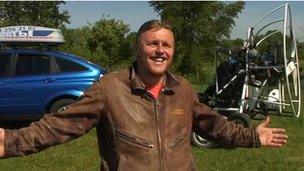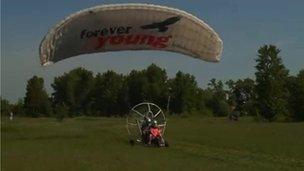My Business: Taking to the skies in Ukraine
- Published
Ruslan Gritsaylo, 40, speaks to the BBC about how he set up a business taking people on paratrike tours in the skies above Kiev
<bold>What makes an entrepreneur? The BBC's Roman Lebed and Tom Santorelli speak to Ruslan Gritsaylo about how he set up a business taking people on paratrike tours in the skies above Kiev. </bold>
"My business is to fly," says 40-year-old Kiev resident Ruslan Gritsaylo, who really does look like a man who loves his job.
Every week he takes customers up in the air on his tiny aircraft known as a paratrike.
A cousin of the microlight, paratrikes look like a tricycle tractor with a huge propeller mounted behind, as well as a big parachute which rises into the sky on take-off.
At first sight it may be difficult to believe that this vehicle can make it into the air, but these doubts quickly eat the dust when the vehicle breaks away from the earth.
<bold>Piloting in the blood</bold>
Mr Gritsaylo is a third generation pilot. His grandfather flew during World War II, and his father was a pilot in the 1970s. He himself flew sports aircraft and was trained as civil aviation pilot.
When the Soviet Union ceased to exist, he realised he could make good money by piloting flights on his own.
"My dear wife Aliona is joking with me: your hobby became a business, and then your business became a hobby. It's all about love," says Mr Gritsaylo.
When he started his business in the 1990s, there was not much competition. There was not enough information about paratrikes - how to construct them or how to fly them safely - so it was a rather dangerous business.
This changed over time as the technology improved, making flights on the micro-vehicles completely safe and civilised, according to Mr Gritsaylo.
"It still can be considered as an extreme sport, but it is more about endorphin then adrenalin," he says.
"It's more about enjoying it rather than being scared of it. The definition of paratrike is one of the safest flying machines ever created by man."
<bold>Between the lines of the law</bold>
In a country well-known for its love of red tape, securing permits to fly paratrikes proved complicated.
Mr Gritsaylo found that many laws in the aviation sphere contradicted each other, and it was very difficult to properly legalise the business for a small private company.
"There are lots of things, which make no sense.
"For example, people come and ask, show me your papers. I say, what kind of papers? and they say, well your pilot licence.
"I have six pilot licences all over the world, but I don't have Ukrainian, because there is no company legally providing official pilot licences for this kind of ultra-light flying machine," he says.

Mr Gritsaylo's father and grandfather were both pilots
So his biggest problem became his biggest opportunity: because of imperfect legislation his aircraft does not require registration.
Otherwise, he would have had to get 11 different permits, which would have been almost impossible.
"It's a balance between 'yes' and 'no' - it's 'maybe'. And between the borders of this 'maybe', you can do everything. We are between the lines of the law."
Mr Gritsaylo carries several thousand customers every year. They stand in line to fly during weekends.
Ten minutes in the sky costs about $60 (£37) - for Ukraine, that is quite a lot of money, but he spreads his net wide to catch customers by using social media and maintaining his own website.
"I follow the rule of big figures - you make lots of calls, lots of e-mails, lots of people. Lots of money," says Mr Gritsaylo, whose phone rings almost every five minutes.
<bold>AirForia euphoria</bold>
His clients are made up of a wide range of people - bankers, office managers, artists, actors - and often people buy certificates to fly as gifts for each other.
People get their biggest kick from night-flights, otherwise known as open-space flights.

Ruslan diversifies his revenue by producing videos of the flights and performing at airshows
Mr Gritsaylo likes to call himself The Man who Brings Happiness. He even named his aero club AirForia, a play on euphoria.
He says that after he started taking people up into the sky he needed to diversify his business model, and now he advertises insurance companies and other companies on his parachutes, flying their banners through the skies and performing paratrike tricks during airshows.
"Take a bottle of milk. How can you earn money with a bottle of milk? Advertise it with an airplane! Where, when, with whom - these are the questions. But every question has an answer. You have to find the connection between the airplane and something you see around".
Mr Gritsaylo also purchased equipment so he could produce high-quality videos of the flights.
He sets the camera right on the nose of his aircraft and claims that he can take better pictures than helicopters can.
"Every year you must make some step forward, because there are lots of people walking behind you. And they are trying to step on your toes. If you don't go forward - they will walk on top of you," says Mr Gritsaylo, with a huge smile on his face.
- Published9 May 2012
- Published2 May 2012
- Published15 February 2012
- Published8 February 2012
- Published1 February 2012
- Published17 January 2012
- Published24 January 2012
- Published7 December 2011
- Published21 December 2011
- Published14 December 2011